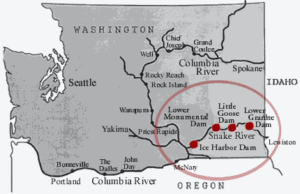
The Lower Granite Master Plan
The US Army Corps of Engineers is revising the Lower Granite Master Plan (LGMP). Lower Granite Lake is formed by Lower Granite dam, the 4th dam on the Snake River. It is located in Washington State, about 40 miles downstream of Lewiston, Idaho. Public scoping is taking place until May 22nd, 2017 and comments received during this process will be considered during development of the draft LGMP. The Corps will also prepare an Environmental Assessment to address potential effects associated with revision of the plan.
How do you provide comments?
You can submit comments on-line here.
You can e-mail comments to: [email protected]
You can submit written comments to:
U.S. Army Corps of Engineers
Walla Walla District
ATTN: Lower Granite Master Plan
201 N. 3rd Avenue
Walla Walla, WA 99362
The Army Corps of Engineers should not be drafting a new Lower Granite Master Plan, unless it is premised on a free-flowing lower Snake River.
Breaching the dams beginning this year is the only salmon recovery measure that will work. If the Master Plan is not premised on a free-flowing lower Snake River, the Corps should draft the plan after the CRSO process is finished, or the dams are otherwise breached.
This is YOUR opportunity to let the US Army Corps know that you value a free-flowing Snake River because it has much greater Recreational, Natural, Cultural and Economic value than a stagnant, fish killing, methane emitting reservoir. Removal of the earthen berm at each dam will return the river to it’s free-flowing state.
We have provided the following talking points that you can include in your comments.
Recreational Value
A free-flowing Snake River:
- Provides whitewater rafting, kayaking, and jet boating opportunities.
- Provides Lewiston with the opportunity to re-develop the riverfront beaches that it once had.
- Provides Lewiston with the opportunity to develop whitewater parks in the Snake and Clearwater Rivers.
Natural Value
A free-flowing Snake River:
- Prevents the impending extinction of Snake River steelhead, sockeye, and Chinook salmon that was started when the 4 lower Snake River dams were constructed.
- Removes barriers to adult fish passage and improves survival for ocean-going smolts by removing the slow-moving reservoirs.
- Improves the spawning habitat of fall Chinook salmon.
- Recovers the riparian areas that were once teeming with wildlife and existed along the free flowing Snake River.
Cultural Value
A free-flowing Snake River:
- Leads to the recovery of place, salmon, steelhead, and lamprey and enhances Traditional Fishing Treaty Rights of the local Native American tribes. They have used the fish for subsistence and ceremonial purposes for centuries.
- Allows the Native American tribes an opportunity to recover and protect the artifacts left by their ancestors along the Snake River that were buried beneath the reservoir waters after dam construction.
Economic Value
A free-flowing Snake River:
- Leads to the recovery of salmon and steelhead fisheries, allowing expanded fishing seasons which spawns increases in hundreds of millions of dollars in angling expenditures. This will be felt hundreds of miles upstream in the small Idaho towns along the Snake, Salmon, and Clearwater Rivers (and their tributaries).
- Allows Lewiston to develop a riverfront community that enhances residents quality of life and attracts new businesses and removes the fears of development behind levees that are prone to overtopping.
- Provides many additional river miles that would be ideal for jet boat usage, which benefits the Lewis-Clark Valley jet boat manufacturers.
- Stops the incessant and needless spending of tax and rate-payer dollars on 4 dams that provide dwindling economic benefit to the Northwest.
- Allows former agricultural lands in the valley to be returned to viticulture, orchards, etc., along with development of spin-off industries such as wineries and supporting tourism infrastructure such as inns, restaurants, river trails, etc., all of which yield many more jobs than the handful derived from current lake recreation.
